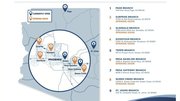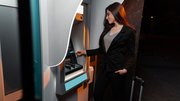News
FIs taking baby steps into ATM future
A trip to a recent industry conference convinced this editor that FIs are most interested in new ATM technologies that will also give them a big bang for their buck in the back office.
June 9, 2004
A recent trip to Diebold's PIX (Partner Information Xchange) conference provided proof that financial institutions are not exactly taking a quantum leap into the ATM future.
It's more like baby steps. Like babies, they are moving ahead -- albeit slowly and a little shakily.
During a Q&A session, Diebold asked its partners -- networks, software providers and transaction processors -- which issues were top of mind for their customers. The issues most frequently mentioned were the migration from OS/2 to a Windows-based operating system, deposit automation and remote key management.
All of these will offer some benefit to the ATM user -- but FIs are obviously most interested in new technologies that also give them a big bang for their buck in the back office.
What about Windows?
Most if not all FIs are using Triple DES upgrades as an opportunity to switch from OS/2 to Windows -- having techs do so at the same time they install new EPPs (encrypting PIN pads) in order to minimize future trips to the ATM -- yet few of them have any short-term plans to use Windows to add new functionality.
According to research conducted by Celent Communications in late 2003, only 36 percent of the FIs switching to Windows said they planned to add new applications in the next 18 months to two years. Early adopters of new functionality have been offering it for quite some time in the OS/2 environment. And largely, that's worked just fine, according to Celent.
Windows will reduce development costs for any new ATM applications when FIs are ready to offer them, however. FIs will be able to use the same business application logic across delivery channels, including the ATM. The content and flow will be the same; only the user interface must be tweaked a bit.
Celent believes that 65 percent of FIs will have switched to Windows by 2005 -- but the move is being driven largely by vendors who are not offering OS/2 on their newest ATM models and will likely stop shipping legacy units with OS/2 over the next two years.
 |
Ann All |
The move is necessary, vendors say, because it will become increasingly costly for FIs to support existing ATMs. There is a shrinking pool of programmers versed in OS/2 and a lack of standard or even custom driver support for new peripherals. IBM has stated its intent to withdraw support for OS/2 in June of 2006.
New products, such as Diebold's Agilis and NCR's APTRA, are designed to allow FIs to use the same software across mixed ATM networks -- largely a result of merger and acquisition activity over the past decade. Again, this will cut operational costs. The new software is designed to run on Windows-based machines only.
Other new products and services designed specifically for Windows environments are beginning to hit the market. One example is a remote ATM management system just introduced by Star Systems that allows ATM owners to quickly and easily change ATM screens and receipts, among other features.
More bang for the buck
Both deposit automation and remote key management also seem to be quickly gaining ground with FIs because of their potential to improve operational efficiences and lower cost.
With the October passage of Check 21, which will go into effect later this year, FIs appear to be taking a serious look at offering check imaging at the ATM. Several research firms including Celent predicted that FIs would implement imaging first in their back office and branches -- and would not get around to doing so at the ATM for several years. Yet they are revising that outlook, based on stronger than expected interest among FIs.
While FIs can generally save money by moving transactions from the teller line to the ATM, that's not true with deposits. Because FIs must collect checks deposited in envelopes at ATMs every day, the costs of offering the service are similar to the teller line. According to Diebold market research, it costs $1.25 to accept a paper check at a teller station and $1 to do so at an ATM. The cost of truncating a check at the ATM is 27 cents, versus 30 cents at a teller station.
An ANSI (American National Standards Institute) committee is currently developing standards for the electronic images that will be used in many cases to replace paper checks, both at the point of presentment and in the back office.
Another ANSI committee is developing standards for acceptable methods of remote key management, which should dramatically reduce the costs of installing a unique encryption key in each ATM. Though most EFT networks have required unique keys per ATM for several years, industry observers say many ATM owners have ignored the requirements because of the high costs of dispatching technicians to ATMs to load keys.
With an increased emphasis on security, networks are expected to begin more strongly enforcing requirements for unique key per ATM. With remote key, ATM owners will be able to comply at a reasonable cost.
For the forseeable future, it seems likely the emphasis will remain on streamlining operations rather than trying to wow customers with new technology.
Included In This Story
Diebold Nixdorf
As a global technology leader and innovative services provider, Diebold Nixdorf delivers the solutions that enable financial institutions to improve efficiencies, protect assets and better serve consumers.














